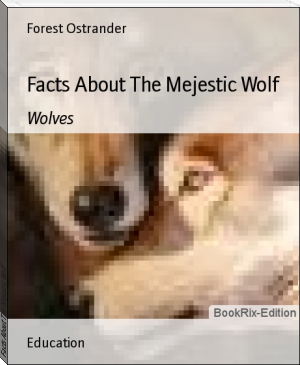The History of The Wolf by Forest Ostrander (good ebook reader .TXT) 📖

- Author: Forest Ostrander
Book online «The History of The Wolf by Forest Ostrander (good ebook reader .TXT) 📖». Author Forest Ostrander
2. Chaos and Retrieval of Intuition as Initiation This stage includes the awareness of self-preservation, questioning early development and identifying cages. During this stage there appear to be thoughts and feelings of confusion and being trapped, depicted by meanderings, mazes, bird and animal cages, lone wolf, Dorothy from The Wizard of Oz, Jack and Jill, or symbols of opposites.
3. Deeper Uncovering of Feelings
The client becomes the lone hunter, facing the life/death/life nature of love, developing relationships that revive dead feelings that bring instincts to the surface again. Anger, hurt, loneliness, love, sexual and fears are expressed in symbols such as: the cross, tombstones, hearts, an animal or human alone or in couples. The client usually begins to play in the sand and reaches the bottom of the sandtray, or make hills and mountains. Anger may be depicted in battles, weapons, monsters, or the color of red in symbols.
4. Centering and Returning To Oneself
The client finds the clear water and begins to nourish the creative life and retrieve a sacred sexuality. Ponds, lakes and rivers, jewels, gold, rings, crowns, and mandalas begin to appear in the sand.
5. Finding One∂s Pack and Returning Home (Or Market Place)
The client, like the wolf, rediscovers her mate and family and begins to live creatively back into the environment or world. A wolf, dog, and other animal families may appear or realistic houses, neighborhoods, and people.
Themes of the Wolf Used in Clients' Sandplay Process
In reviewing the appearance of the wolf in sandtrays of women clients, seven themes emerged:
1. The nurturing and protective goddess mother appearing as the great she-wolf who nursed Romulus and Remus.
2. The lone wolf that is alienated by the family or pack of wolves which allows for differentiation of the young adult in becoming a mature adult.
3. The psychopomp conducting souls through the gates which had to be passed as in Egyptian mythology.
4. The wolf in sheep∂s clothing who attempts to hide its instinctive and wild self by developing a persona of meekness and innocence.
5. The howling wolf who has a voice to celebrate and share with others about successes or to encourage closeness.
6. The wolf and lamb lying together which represents inner peace.
7. The differentiated wolf who has accepted her role in life and is enjoying the present.
Symbolically the wolf appears to represent our instinctive nature that is wild and natural. The wolf can also represent the union of opposites and contradiction. The lone wolf may symbolize the acceptance of natural instincts that had been cut off by family and society and the process of growth and individuation. And the howling wolf illustrates the reclaimed inner voice of the soul.
References:
Brandenburg, J. (1983). Brother wolf: A forgotten promise. Minocqua: Northword Press, Inc.
Cooper, J. C. (1978). An illustrated encyclopaedia of traditional symbols. London: Thames and Hudson Ltd.
de Vries, A. (1984). Dictionary of symbols and imagery. Amsterdam: North-Holland Publishing Company.
Estes, C. P. (1992). Women who run with the wolves: Myths and stories of the wild Woman archetype. New York: Ballantine Books.
The holy Bible. King James Translation. (1947). Cleveland: The World Publishing Company.
Mech, L. E. (1991). The way of the wolf. Stillwater: Voyageur Press.
Neumann, E. (1955). The great mother. New Jersey: Princeton University Press.
Rank, O. (1959). The myth of the birth of the hero. New York: Vintage Books.
Towery, T. L. (1997). The wisdom of wolves: Nature∂s way to organizational success. Franklin, TN.: Wessex House publishing.
Walker, B.G. (1983). The woman∂s encyclopedia of myth and secrets. San Franscisco: Harper San Francisco.
Mariellen Griffith is a Licensed Marriage and Family Therapist in private practice in Bloomington, Illinois.
This article is summarized from the published article, The Wolf in Sandplay, Journal of Sandplay Therapy, Vol, 2, 113-129, 1996.
© 2001Sandplay Therapists of America/International Society for Sandplay Therapy. All rights reserved.
ImprintPublication Date: 05-02-2014
All Rights Reserved
Dedication:
To all the wolves both lost and returning.
 The desire to acquire knowledge about the surrounding world and human society is quite natural and understandable for a person. Life is so developed that an uneducated person will never occupy a high position in any field. Humanity in its mass, and each person individually, develops objectively, regardless of certain life circumstances and obstacles, but with different intensity. The speed of development depends on the quality of training.
The desire to acquire knowledge about the surrounding world and human society is quite natural and understandable for a person. Life is so developed that an uneducated person will never occupy a high position in any field. Humanity in its mass, and each person individually, develops objectively, regardless of certain life circumstances and obstacles, but with different intensity. The speed of development depends on the quality of training.




Comments (0)